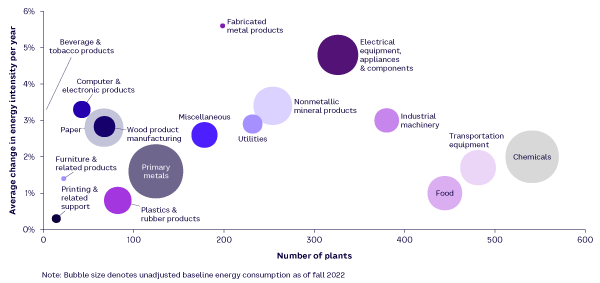Energy-efficiency improvement is a feasible, low-cost approach that, in most cases, does not require any major change to industrial processes and can bring immediate emissions reductions. Since 2010, through the Better Buildings, Better Plants program, the US Department of Energy (DOE) has worked with more than 270 manufacturers and water and wastewater utilities across the US to accelerate the adoption of energy-efficient practices, highlight innovative technologies, and spur change at an organizational level.
Through the program, DOE supports 3,600 facilities, corresponding to 14% of US manufacturers. Collectively, these firms have reported savings of 2.2 quadrillion BTUs (British thermal units) of energy. That is equivalent to 131 million metric tons (MMT) of CO2 emissions reductions and a savings of US $10.6 billion.
Figure 1 shows the average energy-intensity improvement in terms of the number of plants and the program’s energy footprint for selected sectors since 2010. Current energy-efficiency measures in the US industrial sector can potentially save 6.25 quads of energy (6.5% of baseline energy use in 2050) and reduce CO2 emissions by 244 MMT (5.6% of baseline energy CO2 emissions in 2050) through 2050.

Similar studies have been conducted around the world. In 2015, the UK government released a series of reports that assessed the potential for a low-carbon future and developed decarbonization roadmaps for eight of the UK’s most heat-intensive industrial sectors. Per the study, combined max tech pathways (CCUS, electrification, material efficiency, energy efficiency, and other approaches) can reduce emissions from 81 MMT CO2 in 2012 to 22 MMT CO2 in 2050. Energy efficiency combined with heat recovery alone potentially contributes to a reduction in total emissions of 8 MMT CO2 (13% of the overall reduction) in 2050. The main contributors to emissions reductions are the refining industry (43%), the pulp and paper industry (41%), and the food and beverage industry (36%).
Similarly, industrial energy consumption in the EU is projected to drop by 25% in 2050 compared to 2015 levels through energy-efficiency improvements, with waste heat–recovery applications as the primary driver. The energy-efficiency improvements are also expected to reduce energy-related CO2 emissions by 22% in iron and steel sectors, 22% in chemical sectors, 35% in the nonmetallic minerals (e.g., cement, lime) sector, 15% in the nonferrous metals sector, and 32% in refineries in 2050 compared with the baseline scenario. In Australia, energy efficiency in the manufacturing sector could cause a 40% reduction in energy intensity by 2050 compared to 2010 levels.
[For more from the authors on this topic, see: “Energy Efficiency’s Role in Industrial Decarbonization.”]







